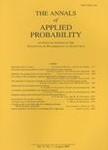-
作者:Meester, Ronald; Roy, Rahul
作者单位:Utrecht University; Indian Statistical Institute; Indian Statistical Institute Delhi
摘要:We consider Boolean models in d-dimensional Euclidean space. Each point of a stationary, ergodic point process is the center of a ball with random radius. In this way, the space is partitioned into an occupied and a vacant region. We are interested in the number of unbounded occupied or vacant components that can coexist. We show that under very general conditions on the distribution of the radius random variable, there can be at most one unbounded component of each type. In case the point pro...
-
作者:Hu, Yiming; Woyczynski, W. A.
作者单位:University System of Ohio; Case Western Reserve University
摘要:We prove that a certain (centered unimodal) rearrangement of coefficients in the moving average initial input process maximizes the variance (energy density) of the limit distribution of the spatiotemporal random field solution of a nonlinear partial differential equation called Burgers' equation. Our proof is in the spirit of domination principles developed in the book by Kwapien and Woycznski.
-
作者:Choudhury, Gagan L.; Lucantoni, David M.; Whitt, Ward
作者单位:Nokia Corporation; Nokia Bell Labs; AT&T; Nokia Corporation; Nokia Bell Labs; AT&T
摘要:We develop an algorithm for numerically inverting multidimensional transforms. Our algorithm applies to any number of continuous variables (Laplace transforms) and discrete variables (generating functions). We use the Fourier-series method; that is, the inversion formula is the Fourier series of a periodic function constructed by aliasing. This amounts to an application of the Poisson summation formula. By appropriately exponentially damping the given function, we control the aliasing error. W...
-
作者:Rhee, WanSoo T.
作者单位:University System of Ohio; Ohio State University
摘要:A fleet of vehicles located at a common depot must serve customers located throughout the plane. Without loss of generality, the depot will be located at the origin. Each vehicle must start at the depot, travel in turn to each customer its serves and go back to the depot. Each vehicle can serve at most k customers. The objective is to minimize the total distance traveled by the fleet. In our model, the customers X1, . . . , X-n are independent and uniformly distributed over the unit disc. If R...

